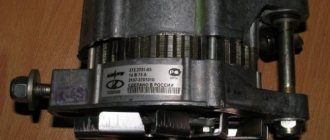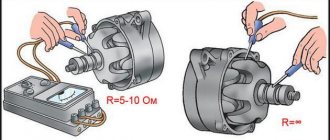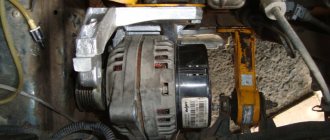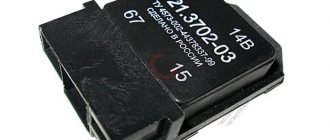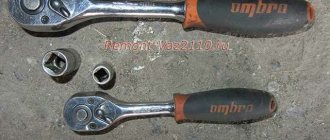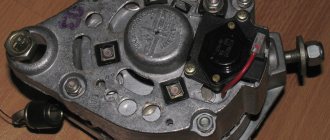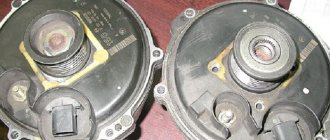02/09/2022 5,736 VAZ 2105
Author: Ivan Baranov
The VAZ 2105 generator provides power to all consumers included in the vehicle’s electrical network, and also charges the battery during operation of the power unit. The article provides a description of the device, typical problems, ways to fix them, and also includes step-by-step instructions on how to remove and connect the unit.
[Hide]
VAZ 21074 injector: generator and importance in the electrical system
VAZ 2107 is one of the legends of the domestic automobile industry. The car was created as a luxury version of the VAZ 2105 model. At the same time, the differences affected not only the interior, but also other key components. In total, there are about 15 modifications that differ from the basic version. Unfortunately, the company's management decided to close production in 2012.
Over the course of 30 years, a huge number of cars of the described model were created. One of the most popular is the VAZ 21074, which received an engine from the VAZ 2106 model.
During their service, many cars have undergone repairs of varying complexity more than once. Let's look at the generator and its associated faults.
- Difference between carburetor and injection systems
- Note
- Purpose
- Types of breakdowns
- Main details
- What should you pay attention to?
- Malfunctions and their elimination
- Constantly lit indicator (even when the ignition is turned off)
- Devices and sensors do not work
- The battery indicator is always on when the ignition is on
- The indicator flashes
- Noise
- Voltage drops
- Completion
Capacitor check
The capacitor serves to protect the vehicle's electronic equipment from voltage surges in the ignition system, as well as to reduce interference with radio reception. Damage to the capacitor or loosening of its fastening on the generator (deterioration of contact with the housing) is detected by an increase in interference to radio reception when the engine is running.
Approximately the serviceability of the capacitor can be checked with a megger or tester (on a scale of 1-10 MOhm). If there is no break in the capacitor, then at the moment the probes of the device are connected to the terminals of the capacitor, the arrow should deviate in the direction of decreasing resistance, and then gradually return back. Capacitor capacity 2.2 µF±20%.
Source
Battery charging circuit
For a general understanding of the reasons for overcharging, first consider the battery charging circuit diagram. And although it is structurally different on different cars, the general principle of construction is the same.
This circuit includes:
- Generator.
- Rectifier block (diode bridge).
- Relay regulator.
- Fuse box.
- Egnition lock.
- Charge indicator lamp.
- Battery
The charging system works using the example of the VAZ 2106 and other cars from the “VAZ classic” series as follows:
- After starting the power plant, through a belt drive, the crankshaft begins to rotate the generator rotor, as a result of which this unit generates electricity.
- Since automobile generators use alternating current, the generated energy goes to the rectifier unit, where alternating current is converted into direct current.
- After the rectifier unit, the electricity is supplied to the relay regulator, whose task is to maintain the voltage in a given range.
- After the regulator, the electrical energy passes through the circuit through the fuse box, the ignition switch and the charge indicator lamp, then returns to the output of the generator, and from there it is supplied to the battery.
The detailed diagram is shown below.
How to solve a problem
The procedure for finding the reason why the generator does not charge the battery:
- Check to see if the accessory drive belt (or alternator belt) is broken. If the belt is intact, check its tension.
- If the belt tension is normal, but the warning light is still on, check that the wiring harness block and the positive wire terminal are securely connected to the generator. Please note that wires may be broken or broken within the insulation.
- Check the reliability of the wire connections to the battery terminals.
- Check the integrity of the generator fuse in the engine compartment mounting block. Replace the blown fuse if necessary.
- If, after all the measures taken, the charging lamp continues to light while the engine is running, then most likely the generator is faulty (for example, the voltage regulator is faulty
Generator faults
- The generator generates current at a very low voltage.
- The generator has stopped producing electricity.
- The dashboard lamp indicates a generator breakdown.
- The generator generates current above the optimal rate.
- Extraneous noise arose when the generator was operating.
Before you begin repairing the generator, check the condition of the generator drive belt for wear and belt tension (the check is carried out by pressing on it, the belt should not bend more than 2 mm). If the belt is not very worn, the tension can be corrected by tightening it a little. Check the tension roller of the generator; it should turn easily and not make unnecessary sounds (if the roller does not scroll well and makes unnecessary sounds, it should be replaced). Then you should remove and disassemble the generator to check the technical condition of the generator.
Generator diagnostics
In the future, you will need the following measuring instruments to check the technical condition of the generator :
- ammeter;
- voltmeter;
- rheostat.
The rotation speed of the generator rotor can tell us a lot, which we can check using the tachometer on the instrument panel. Normal tachometer readings with a working generator should be in the range from 2000 to 5000 rpm.
Causes of generator malfunction and repair, possible causes of generator failure:
If during testing you find that the generator does not produce a charge, this may be due to the following reasons:
- Contacts or fuse are burnt out.
- Damage or wear of the generator brushes.
- Regulator relay malfunction.
- A break in the stator or rotor circuit due to a short circuit in the winding.
Elimination of the above listed generator malfunctions is solved by replacing worn parts.
How to remove and disassemble the generator. Do-it-yourself generator disassembly.
- Remove the brush holder with the voltage regulator, having first unscrewed all the fasteners.
- Remove the tension bolts and the cover with the stator.
- Disconnect the phase windings from the output wires of the rectifier unit, and then remove the cover from the stator.
- Remove the pulley from the generator shaft and the front cover using a puller.
Generator repair
If the generator winding is shorted or the winding is broken, it is necessary to replace the wires with new ones. Usually the winding breaks in close proximity to the slip rings. Pay attention to the ends of the winding to see if any desoldering has occurred. To eliminate this malfunction, it is enough to unwind the turn in the area of the break back from the rotor winding. Remove the broken end of the winding from the slip ring and solder the unwound wire.
If you find that the alternator is generating a weak or excessive charge , this is a sign of a bad alternator relay. The breakdown can be eliminated by replacing the generator relay. If the generator is working properly and the light is blinking, this indicates a breakdown of the light bulb power diode in the indicator. Such a breakdown can be eliminated by replacing the diode in the generator.
Extraneous noises during generator operation indicate wear of the rotor bearing. The generator should be disassembled, the bearing removed, and inspected for defects. If the alternator bearing is worn, replace it.
To assemble the generator, carry out all steps in the reverse order. You can repair the generator yourself, in your garage, the main thing is to follow safety precautions, be careful with electrical appliances, carefully remember the sequence of disassembling the generator, so as not to sit for a long time on its assembly.
Generator device VAZ 2101, VAZ 2102, VAZ 2104, VAZ 2105, VAZ 2106, VAZ 2107, VAZ 2108, VAZ 2109, VAZ 2110
1 – “negative” brush; 2 – brush holder; 3 – “positive” brush; 4 – neutral wire plug block; 5 – insulating bushings of the contact bolt; 6 – rectifier block; 7 – contact bolt; 8 – stator; 9 – rotor; 10 – inner bearing mounting washer; 11 – drive side cover; 12 – fan assembly with pulley; 13 – outer bearing mounting washer; 14 – front rotor bearing; 15 – spacer ring; 16 – coupling bolt; 17 – clamping sleeve; 18 – cover from the side of the slip rings; 19 – buffer sleeve; 20 – bushing
Frame
It consists of two covers - back and front.
The latter is located on the side of the crankshaft drive pulley. Both generator covers are connected using several long bolts. The material of manufacture is aluminum. It dissipates heat easily and is non-magnetic, which is very suitable for generator operation. The body also has ventilation holes and mounting claws.
Malfunctions of the VAZ 2105 generator and their elimination
The generator set ensures uninterrupted operation of the vehicle's electrical equipment while driving and charges the battery by converting mechanical energy into electrical energy. It is important to monitor its condition so that problems do not arise along the way. You can diagnose and fix generator problems yourself, without involving specialists, by following step-by-step instructions.
Design and principle of operation of the generator set
The VAZ 2105 was equipped from the factory with generators G-222 and 37.3701.
Diagnostics and repair of generator on VAZ cars
Checking the functionality of the generator 37.3701
Recently, cars from the Volzhsky plant have been equipped mainly with model 37.3701 generators. Let's consider practical steps to find generator faults and eliminate them. Typically, generator malfunctions include the following:
The battery is constantly discharged due to the complete inoperability of the generator.
With increased electricity consumption, the generator cannot cope with the load, and the on-board network voltage becomes lower than 13 Volts.
The generator produces high voltage (more than 16 Volts), which leads to overcharging of the battery (electrolyte boiling away).
First of all, when checking charging, you should check the voltage on the battery at engine speeds of about 2500 rpm. min. If everything is normal, then the voltmeter will show the voltage within 13.8-14.5 Volts. If the voltage during testing is lower than 13 Volts, then the generator should be checked in the following sequence:
Check the quality of the grounding buses of the power unit and battery. Connections between the battery and terminal “30” of the generator.
If the “battery” indicator light does not light up and the instruments on the dashboard do not work, check fuse number 5 in the relay block (for VAZ-2108), or number 10 for VAZ-2105.07. Check the voltage at plug “61”, having previously removed it from the generator with the ignition on, there should be a voltage of 12.5 Volts. Check the condition of additional resistors in the fuse block (VAZ-2108, two resistors of 100 Ohms and 2 W each) or in the instrument cluster (NIVA 21213).
Check the integrity of the armature winding using a test lamp and a battery, having previously removed the integral stabilizer to facilitate access to the armature ring contacts. Also, using a test lamp, check whether there is a short circuit of the armature winding to the housing.
Start checking the integrated generator stabilizer. Connect a light bulb (12 Volt 1-3 W) to the brushes of the integral stabilizer (terminals B, W). Apply a voltage of 12 Volts between the body (-) of the integral stabilizer, and its outlet under contact “30” and terminal “B” (+) . When this happens, the lamp should light up. When the voltage increases by more than 15-16 Volts at terminal “B”, the lamp should go out. If this does not happen, then the integral stabilizer should be replaced.
For further inspection, it is necessary to remove the generator from the car and disassemble it.
Using a test lamp, check all generator diodes. Six main, and three auxiliary. It should be noted that for simplicity of design, one of the three power diodes has an anode on its body, and the other three have a cathode. This should be taken into account when checking the diode bridge. Before checking, it is necessary to disconnect the stator winding taps from the diode bridge.
Check visually, as well as using a test lamp and battery, the condition of the stator winding. They are connected to each other by a star, without forming a midpoint.
If necessary, replace the generator bearings with new ones.
Generator circuit 37.3701. It should be remembered that contacts “K1” and “K2” are shown here conditionally, for ease of understanding of the circuits. You won't find them on a real car. Contact “K1” is connected to the vehicle’s (+) power supply bus. Contact “K2” is connected to the “battery” warning lamp; on different VAZ models, this connection diagram is different. See connection diagrams below.
Alternator operation indication diagram for VAZ-2105.07. When checking, you should pay attention to the condition of the generator drive belt, the presence of a reliable connection of the power wires “ground” and the positive bus between the battery and the generator. Check the condition of the brushes of the integral stabilizer, the condition of fuse number ten in the mounting block. Quality of ignition switch contacts.>
Alternator operation indication diagram for VAZ-2108. When checking, you should pay attention to the condition of the generator drive belt, the presence of a reliable connection of the power wires “ground” and the positive bus between the battery and the generator. Check the condition of the brushes of the integral stabilizer, the condition of fuse number five in the mounting block. Quality of relay contacts and ignition switch.
To determine the degree of battery discharge, you should measure the electrolyte density with a car dynamometer. If the battery is discharged by more than 25% in winter and 50% in summer, then it should be removed from the car and recharged with a current equal to 1/10 of the battery capacity for ten hours, until the electrolyte begins to visible boil.
Guide to removing and connecting the generator
To establish on a VAZ 2105 the reasons why the battery is not charging or power is not supplied to the consumers of the on-board network, you need to check the generator. It must be removed for diagnosis and repair.
1. Unscrew the fastening nut.
2. Remove the drive belt.
3. Removing the device from the engine.
The withdrawal procedure consists of the following steps:
- First of all, disconnect the terminals on the battery and remove it so that the upper bolt of the unit is accessible.
- Next, we remove the protection from the engine.
- Using an extension cord and a 12mm socket screwdriver, unscrew the nut that secures the generator unit to the adjustment bar. Then you need to loosen the fastening nut on the bracket.
- To remove the drive belt, move the unit slightly. As soon as the belt loosens, remove it.
- Disconnect the block with wires from the assembly.
- We unscrew the fastening nut of the tip of the wires that are connected to the battery positive.
- Then the nut securing the unit to the bracket on the motor block is unscrewed.
- Now you can dismantle the unit and either replace or repair the generator.
After completing the repair work, the generator unit must be connected. Install in its original place, tighten all fasteners. Put on the drive belt and adjust its tension. Connect the plug with the wires. Install the battery and connect the terminals.
When connecting the VAZ 2105 generator, you should follow the diagram that can be found in the car manual.
Price issue
The cost of repair depends on the parts being replaced. The generator costs from 3,850 rubles, the generator bar - 205 rubles, the tracks on the anchor of the generator mechanism - 450 rubles, nuts from 10 rubles, bearings 110 rubles, the generator winding - 910 rubles, the starter armature - 1300 rubles, drive belt - 500 rubles, diode bridge - 600 rubles. Disassembly costs 300 rubles. Do-it-yourself repairs will save you on maintenance costs.
Loading …
How to check the serviceability of the VAZ 2107 generator?
First, let's find out what the generator consists of, in principle. With some exceptions, all car generators have a similar list of components:
- Rotor . This is the part of the generator that rotates.
- Stator . It is also the housing on which the capacitor and contact terminals are mounted. Bearings for the rotor are also firmly mounted in the housing.
- Front and back covers . Removable, provide access to the “insides” of the generator.
- Voltage regulator . It can be built-in (integrated into the design) or replaceable.
- Mounting points.
The main generator malfunctions are of the same type, as are the methods for eliminating them. It is well known that when the charge current is insufficient, when the arrow is in the initial sector of the scale, the first thing to do is check how the generator drive belt is tensioned. If it slips, the pulley will not be able to rotate properly. If the generator fuse is intact and the drive belt is tight, it is worth checking the following points:
is there a break in the conductors from the generator terminal marked “30” to the contact marked “15”;
brush holder mounting screw. A short circuit may occur as a result of wear of the plastic fasteners;
whether the commutator group is dirty, whether the generator brushes are worn out;
Is there a short to ground in the generator excitation winding? It is checked with a tester (multimeter) in the “circuit ringing” mode;
You can also check for an open (or short circuit) of the diode group of the rectifier unit.
If the voltmeter needle is always in the red sector of the maximum current, you need to find out if there is any unwanted contact between the brush bus and the brush holder mounting screw. In addition, it is possible that the generator voltage regulator does not perform its function, which means it requires replacement.
Stator check
The stator is checked separately after disassembling the generator. The terminals of its winding must be disconnected from the rectifier valves. First of all, check with an ohmmeter or using a test lamp and a battery to see if there are breaks in the stator winding and if its turns are shorted to the housing.
The insulation of the winding wires must be without signs of overheating, which occurs when there is a short circuit in the rectifier valves. Replace the stator with such damaged winding. Then check with a special flaw detector whether there are any short-circuited turns in the stator winding.
Basic malfunctions and ways to eliminate them
You can check the VAZ 2105 generator injector for serviceability on the car without removing it from the engine. Problems can be identified using diagnostics, using the diagram, and then eliminated (author of the video - Autoelectrics HF).
The motor is running, but the voltmeter needle does not leave the red zone
The voltmeter needle is in the white zone, but the mains voltage is below 13.6V, the battery is not charging
The voltmeter pointer is moving towards the yellow zone, the battery is overcharging, the voltage in the network exceeds 14.7V
The ignition is turned on, the voltmeter needle does not move
Increased noise during operation of the generating set
Device Description
On the VAZ 2105, generator units G 222 were first installed, and since 1987, model 37.3701 began to be installed. The device is a 3-phase electromechanical machine with an electromagnetic exciter that converts the mechanical energy of a rotating rotor into electrical energy. Rotations are transmitted to the rotor through the VAZ generator drive belt, mounted on the crankshaft pulley. The unit is located on the right in the engine compartment in front of the engine.
Device design diagram
In the design of the generator unit:
- stator;
- rotor;
- graphite brushes of the VAZ generator;
- voltage regulator;
- rectifier;
- relay-regulator.
Generator connection diagram
The maximum output current of the generator unit is 55 (45) Amperes. The operating voltage is 13.6-14.6 Volts. Right rotation.
Sometimes, after repair or tuning, generators from a VAZ 21053 or 2108 are installed on models manufactured before 1987. If the connection is incorrect and the circuit is violated, the battery will not charge.
Read also
Generator belt
Generator belt Many beginners forget that the drive belt of the generator and attachments must be replaced periodically (Fig. 4.1). As a result, it bursts at the most inopportune moment (usually where the nearest service station is far away, and in general it’s not close to civilization),
5-8. The deceptive simplicity of a spiral explosive magnetic generator. Visit to the nuclear weapons development center. The first open publication about the emitter
5-8. The deceptive simplicity of a spiral explosive magnetic generator. Visit to the nuclear weapons development center. The first open publication about the emitter Proposed in the 50s by A. Sakharov, the spiral VMG (SVMG) looks like a primitive device (Fig. 5.10): a spiral, and inside
2.4. Malfunctions and their elimination
2.4. Malfunctions and their elimination Before you begin to search for a possible malfunction in the engine, you need to determine its type: gasoline or diesel, carburetor or injection. For an injection engine, you should find out which fuel injection system it has
3.3. Malfunctions and their elimination
3.3. Malfunctions and their elimination Before you begin to eliminate the malfunction, you need to determine its source. Let's look at the most common malfunctions: 1. Insufficiently efficient cranking of the engine crankshaft by the starter, dim light
Engine malfunctions
Engine malfunctions The starter armature does not rotate when the ignition switch is turned on Malfunctions of the starting system Check the operation of the starter in one of three ways: 1. Make sure the cable connections of the lugs on the battery terminals are secure. Release
Clutch faults
Clutch malfunctions The clutch is slipping. Insufficient acceleration of the vehicle when engine speed increases. Loss of power when driving on an incline. Burning smell from an overheated clutch Lack of free play in the hydraulic clutch pedal.
Suspension faults
Suspension faults Rocking, instability and vibration of the vehicle on uneven roads Assess the suitability of the shock absorber. Inspect the shock absorber (hydraulic strut) for oil leaks. Check how effectively the shock absorber dampens
Tire faults
Tire malfunctions Dependence of tread wear on air pressure in tires Operation of tires with increased pressure. Increased wear of the middle part of the tire. Its rigidity increases. Increased tire cord stress and small cracks occur on the side walls.
Electrical faults
Malfunctions of electrical equipment The battery requires attention The battery discharges slowly during operation. The starter cranks the engine at a low speed. Current leakage through damaged insulation of any wire or device - from here
Starter malfunctions
Starter malfunctions If something more serious happens than a winding break or an interturn short circuit (the probability of which is not excluded, but is extremely small), the causes of failure may be a malfunction of the starter itself or purely external ones - without
Possible faults
Possible malfunctions If the motor does not rotate, check the polarity of the diodes. Make sure you connect them correctly, following the polarity shown in the diagram. If the stepper motor rotates slowly or oscillates back and forth, it may be
2.1. Typical faults
2.1. Typical faults In the first case, it is necessary to replace the magnetron and check the serviceability of the high-voltage diode. Because in practice, the diode fails when the magnetron malfunctions. A faulty magnetron will look absolutely “like new”, thus
Clutch faults
Clutch malfunctions The most typical malfunctions: – the clutch does not disengage completely (slipping); – incomplete disengagement of the clutch (the clutch “drives”); – jerking when the clutch is engaged. Slipping is the slipping of the driven disk
Possible generator malfunctions
Possible generator malfunctions Fig. 11. Cleaning the contact rings with sandpaper and replacing the brushes. Rice. 12. Checking the resistance of the rotor field winding. Rice. 13. Stator test circuit
Tire faults
Tire malfunctions Main malfunctions: – wear; – punctures and cuts; – delamination and rupture of the frame. Most often, tires wear out due to non-compliance with air pressure standards in tires. If the pressure is too high, the contact area of the tire with the ground is reduced,
Reasons for the battery not charging
To start the engine and proper operation of the ignition system and other electrical circuits of the VAZ 2105, it is necessary to have DC voltage in the on-board network. When the engine is not started, the battery maintains the proper voltage. After the engine starts, the car's generator charges the battery and maintains the on-board voltage at 13.6-14.2 V.
Checking the battery charge using a voltmeter
Regardless of engine speed, the output voltage at the generator remains constant. A relay-regulator is responsible for this, which changes the voltage of the generator excitation circuit. If the voltage rises above the permissible level, the winding current decreases, reducing the output voltage. And vice versa.
If the VAZ 2107 has lost charging, the reasons may be as follows:
- Generator malfunction;
- break or poor contact in the excitation network or generator output voltage;
- broken generator belt.
Restoring normal operation of the generator should begin by determining the reason for the lack of battery charge.
VAZ 2105 generator malfunction
Experts suggest that on a VAZ-2107 with an injector, the standard generator is 5142.3771 (eight). It has one very important feature: it produces more current - not 55A per hour, like other generators, but about 80-90 A. This is due to the properties of the injector, which requires more electricity (but also has a higher power density).
Car battery current leakage
Experts advise checking the generator for malfunctions in the following order:
- inspect the diodes that supply electricity to the excitation winding of the generator (if they are burned out, they should be replaced with new ones);
- use a tester to measure the voltage level in the current-carrying circuit (if its value is less than 12 V, then there may be a short circuit, which means the wiring is overheating).
Break or poor contact in the excitation network or generator output voltage;
Often, symptoms that indicate characteristics of a faulty generator can also appear as a result of completely different problems. As an example, poor contact in the fuse socket of the generator field winding circuit will indicate a generator malfunction. The same suspicion may arise due to burnt contacts in the ignition switch housing. Also, the constant lighting of the generator malfunction indicator lamp can be caused by a breakdown of the relay; the blinking of this switching lamp may indicate a generator malfunction.
Broken alternator belt
As a rule, the generator belt breaks due to its wear. While working, it is under a fairly decent load, and although modern belts are made of very durable materials, over time the following appear:
- abrasions;
- cracks;
- teeth wear off;
- the edges are fraying.
If you find at least one of these signs, then do not delay replacing it; the consequences will not take long to arrive. A characteristic whistle can indicate that something is not right with the drive. This usually happens in wet weather. It happens that it disappears while driving, but sometimes it doesn’t. This occurs due to the weakening of the belt tension. Sometimes it is enough to use tension mechanisms to tighten the belt more, but, as a rule, it needs to be replaced.
You can replace the drive yourself - this is not a difficult job, or you can contact a service station. It's up to you, but he should be fine. If the alternator belt breaks, don’t worry. This is a non-critical failure. It’s just that now, when you start driving, the battery will stop charging, and the systems will begin to intensively consume battery energy.
